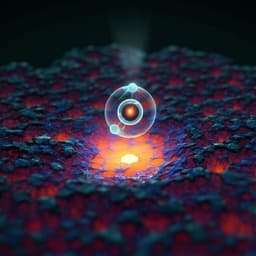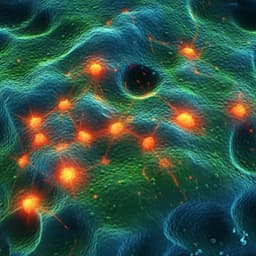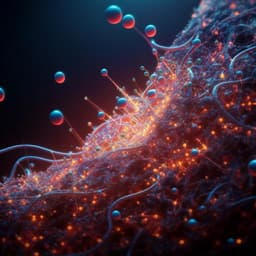
Chemistry
Photoinduced loading of electron-rich Cu single atoms by moderate coordination for hydrogen evolution
W. Fu, J. Wan, et al.
Discover how researchers Weiwei Fu, Jin Wan, Huijuan Zhang, Jian Li, Weigen Chen, Yuke Li, Zaiping Guo, and Yu Wang developed a groundbreaking single-atom catalyst that lowers overpotential to just 41 mV for hydrogen evolution, showcasing remarkable synergy among neighboring copper atoms on a black phosphorus support.
~3 min • Beginner • English
Introduction
Single-atom catalysts (SACs) enable 100% metal dispersion and often exhibit distinct active sites and catalytic pathways with superior activity and selectivity. Conventional strategies to stabilize SACs use heteroatom coordination (N, O, S), defects, MOFs, zeolite confinement, or strong metal–support interactions, but can involve complex syntheses, sensitive conditions, and risk of aggregation at higher metal loadings. Strong coordination can also withdraw electron density from metal centers, hindering reduction reactions that favor electron-rich sites. Thus, a key challenge is to stabilize high-loading single atoms with moderated coordination that preserves electron richness while preventing agglomeration. This study proposes black phosphorus (BP) as a low-electronegativity support to anchor Cu (and Co) single atoms in a moderately coordinated M–P3 environment via a room-temperature, hydrogen-assisted photochemical route. The hypothesis is that such electron-rich, neighboring single Cu sites will optimize ΔGH* and lower water dissociation barriers, thereby accelerating alkaline hydrogen evolution reaction (HER) kinetics.
Literature Review
The paper reviews the rapid development of SACs across reactions such as oxygen reduction, CO oxidation, and hydrogenation. It highlights dispersion strategies: defect engineering, MOFs, zeolite encapsulation, and enhanced metal–support interactions, noting limitations like complex processing, sensitivity, and aggregation at high loadings or high-temperature pyrolysis that harm reproducibility. It discusses the role of heteroatom coordination (N, O, S) in stabilizing single atoms through strong bonds, but warns these can shift metal d-band centers and withdraw electron density, detrimental for reduction reactions requiring electron-rich active centers. The authors identify a gap for supports that can stabilize single atoms without overly strong heteroatom coordination, enabling high-loading, electron-rich SACs.
Methodology
Synthesis: Bulk black phosphorus was exfoliated in N-methyl-2-pyrrolidone (NMP) under Ar to form ~2.4 nm-thick 2D BP nanosheets. Cu(Ac)2·H2O or Co(Ac)2·4H2O precursors were adsorbed onto BP in NMP (up to ~30 wt% adsorption). A room-temperature, hydrogen-assisted photochemical reduction was performed under flowing H2 (40 mL min−1) with a 300 W Xe lamp (λ > 400 nm) for 3 h, yielding single-atom Cu/BP and Co/BP. A bimetallic CuCo/BP was prepared similarly with both precursors. For nanoparticle controls, precursor-loaded BP was thermally treated at 500 °C under Ar. Characterization: TEM/AFM confirmed exfoliation; HAADF-STEM visualized high-density, neighboring single-atom groups (inter-atom spacing ≥0.29 nm) and uniform dispersion (STEM-EDS). XRD showed no crystalline Cu/Co phases. XAFS (XANES/EXAFS) at Cu and Co K-edges determined valence and local coordination, supporting single-atom M–P3 structures and absence of M–M scattering. UV-Vis DRS, UPS, and band diagrams established suitable band alignment and reduced band gap upon metal loading. ESR with DMPO probe under visible light and H2 detected DMPO–H adducts (nine-line signal), evidencing H· formation on BP; pH decrease (6.7 to 5.3) corroborated H· generation. XPS tracked P, Cu, and Co valence shifts upon reduction and lower P–O signals, consistent with electron-rich P and stabilized BP. Electrochemistry: HER in 1 M KOH was assessed using a three-electrode setup (glassy carbon working electrode, Hg/HgO reference, carbon rod counter), with LSV (95% iR-compensated), Tafel analysis, EIS (Nyquist), double-layer capacitance (Cdl) for ECSA, chronoamperometry (stability at 10 and 50 mA cm−2), CV durability (2500 cycles), and faradaic efficiency by gas quantification. Catalysts compared: n-Cu/BP (11.3 wt% Cu), n-Co/BP (5.2 wt% Co), CuCo/BP (8.8 wt% Cu, 3.7 wt% Co), Pt/C, BP, Cu2+/BP, and Cu NPs/BP. Computation: DFT (VASP, PAW, PBE-GGA, D3 vdW) on 3×3×1 BP monolayer slabs with sufficient vacuum; relaxations (3×3×1 k-grid), electronic properties (6×6×1), energy cutoff 450 eV. Bader charge, DOS, and ICOHP analyses characterized electronic structures and bonding. AIMD tested stability at 500 K (10 ps). CI-NEB computed water dissociation barriers for isolated and neighboring M sites; ΔGH for H adsorption was computed including ZPE and entropy.
Key Findings
– High-loading single-atom Cu and Co were synthesized on BP via hydrogen-assisted photochemical reduction at room temperature, achieving 11.3 wt% Cu for n-Cu/BP and 5.2 wt% Co for n-Co/BP, with no crystalline metal phases by XRD and atomic dispersion by HAADF-STEM/XAFS. Cu atoms exhibit slightly positive valence (between 0 and +1) and a Cu–P3 coordination. – ESR with DMPO confirmed formation of hydrogen radicals under visible light and H2; H2 served as a hole-trapping agent, boosting single-atom loading. pH of supernatant dropped from 6.7 to 5.3 after H2 treatment. No metal reduction occurred in the dark under H2. – Band characterization: BP and Cu/BP band gaps of ~1.17 and 1.06 eV, respectively; EVB 0.72 eV (BP) and 0.7 eV (Cu/BP) vs NHE; photoreduction of Cu/Co ions is thermodynamically favorable. – Electrocatalytic HER (1 M KOH): n-Cu/BP shows an overpotential of 41 mV at 10 mA cm−2 (close to Pt/C: 39 mV) and a Tafel slope of 53.4 mV dec−1 (Pt/C: 58.8 mV dec−1; n-Co/BP: 131.6 mV dec−1), outperforming n-Co/BP and CuCo/BP. Exchange current density j0 for n-Cu/BP is ~1.91 mA cm−2. Cu2+/BP and Cu NPs/BP are much less active, indicating the importance of atomically dispersed Cu–P3 sites. – TOF and mass activity: At 150 mV overpotential, TOF of n-Cu/BP is 0.53 H2 s−1, versus 0.17 H2 s−1 for CuCo/BP and 0.12 H2 s−1 for n-Co/BP. Specific current for n-Cu/BP reaches 5.49 A mg−1 at 300 mV, over four times that of CuCo/BP or n-Co/BP. – EIS and ECSA: n-Cu/BP has the lowest charge transfer resistance (Rct = 16.7 Ω) compared to CuCo/BP (22.3 Ω) and n-Co/BP (78.4 Ω), largest Cdl (49.0 mF cm−2 vs 37.9 and 22.3 mF cm−2), and highest ECSA-normalized intrinsic activity, linking performance to neighboring Cu site synergy. – Stability and FE: n-Cu/BP maintains stable overpotentials over 22 h at 10 and 50 mA cm−2; retains ~90% activity after 2500 CV cycles; FE for HER ~100%. Post-cycling HAADF-STEM/XAFS confirm single-atom dispersion is preserved; BP alone oxidizes (to red P/POx) under long-term operation, while n-Cu/BP remains structurally intact. – Loading effects: Increasing Cu or Co loading reduces overpotential up to an optimum (Cu 11.3 wt%), beyond which aggregation to nanoclusters (e.g., 15.8 wt%) degrades activity. Adjusting Cu:Co ratios in CuCo/BP shows increasing Cu content improves HER up to a point; neighboring Cu sites are superior to neighboring Co or CuCo sites. – DFT insights: Cu/BP shows metallic behavior with Fermi level crossing conduction band; Cu 3d band center is most negative (−3.51 eV) among Mo, Fe, Co, Ni on BP, indicating electron-rich Cu sites. ΔG_H for Cu–P3 is −0.06 eV (near ideal), consistent with optimal H adsorption. Water dissociation barrier on neighboring Cu sites is 0.63 eV versus 1.82 eV for isolated Cu, revealing a dramatic kinetic advantage in the Volmer step. Replacing Cu with Co increases barriers. Charge transfer analysis shows moderate M–H interaction for Cu and electron donation from metals to BP; ICOHP correlates with charge transfer and M–H bonding strength.
Discussion
The study addresses the challenge of stabilizing high-loading single atoms without overly strong heteroatom coordination that depletes electron density. By using BP, whose P atoms offer moderate coordination (M–P3) and low electronegativity, the Cu single atoms retain an electron-rich character that optimizes hydrogen adsorption (ΔG_H near zero) and enhances HER kinetics. The hydrogen-assisted photochemical method generates surface H radicals that accelerate metal-ion reduction and raise single-atom loading while avoiding aggregation. Experimentally, n-Cu/BP exhibits exceptionally low overpotential and favorable Tafel slope, high TOF and mass activity, low charge-transfer resistance, and robust stability and faradaic efficiency, outperforming isolated Cu sites, Co-based SACs, and CuCo bimetallic sites. DFT reveals that neighboring Cu single atoms work synergistically: one Cu site stabilizes H*, while the adjacent Cu binds OH−, substantially lowering the water dissociation barrier and accelerating the Volmer step. This explains the superior kinetics of neighboring Cu configurations compared to isolated Cu or Co-containing analogs. The approach also stabilizes BP against oxidation under operation. Overall, the findings validate the hypothesis that moderate coordination on BP and neighboring single-atom configurations together provide optimal electronic structure and reaction pathways for alkaline HER.
Conclusion
A room-temperature, hydrogen-assisted photochemical strategy was developed to create high-loading, electron-rich Cu (and Co) single atoms on black phosphorus, forming moderately coordinated M–P3 sites. The resulting n-Cu/BP achieves 11.3 wt% atomic loading and delivers outstanding alkaline HER performance (41 mV at 10 mA cm−2; Tafel 53.4 mV dec−1; TOF 0.53 H2 s−1 at 150 mV), high intrinsic activity, low charge-transfer resistance, and durable stability with near-100% faradaic efficiency. Mechanistically, neighboring Cu single atoms synergize to facilitate water dissociation with a much-reduced activation barrier and near-ideal hydrogen adsorption free energy, as supported by DFT. These results demonstrate a generalizable concept for stabilizing high-load single atoms with preserved electron richness via moderate coordination, and highlight the kinetic advantages of neighboring single-atom ensembles. Future research may extend this strategy to other metals and supports, explore operation in diverse electrolytes and conditions, and design controlled neighboring-atom architectures to tailor multi-step reaction pathways.
Limitations
The catalytic evaluations focus on alkaline HER (1 M KOH); performance in acidic or neutral media was not examined here. The synthesis and mechanism are demonstrated primarily for Cu and Co on black phosphorus; broader generality to other metals and supports requires further validation. Stability tests cover up to 22 h chronoamperometry and 2500 CV cycles; longer-term durability and device-scale testing were not reported.
Related Publications
Explore these studies to deepen your understanding of the subject.







